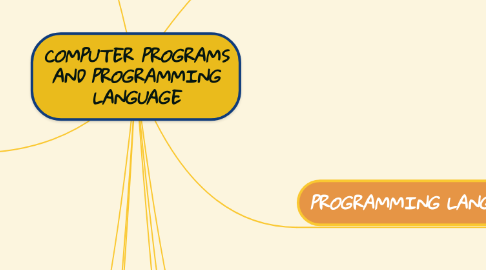
1. PROGRAMMING LANGUAGE PARADIGMS
1.1. MODEL A CLASS PROGRAMMING LANGUAGE THAT SHARE COMMON CHARACTERISTICS & DIFFERENCES
2. cOMMON PROGRAMMING PARADIGMS
2.1. 1. IMPERACTIVE PARADIGM - sequential exucation of instructions & use variables representing memory locations.
2.1.1. LANGUAGE : C , Pascal, FORTRAN
2.1.1.1. KEY FEATURES : Stored memory - Mutable variables - Sequencing, selection & iteration - Pointers.
2.2. 2. OBJECT - ORIENTED PARADIGM - programmer to write reusable code that mimics the behavior of object in the real world.
2.2.1. OOP ( Organized around object rather actions, data rahter then logic ).
2.2.1.1. LANGUAGE : Smalltalk , C ++ & Java
2.2.1.2. KEY FEATURES : Abstraction- Encapsulation - Inheritance - Polymorphism.
2.3. 3. LOGIC PARADIGM - symbolic logic.
2.3.1. Declarative & rational style of programming.
2.3.1.1. LANGUAGE : Prolog
2.3.2. CONCEPT : Horn clauses
2.3.2.1. FACT & RULES : Clauses ( logic variables ) that take any value necessary to make facts or the left side of the rule match a goal.
2.3.2.1.1. KEY FEATURES : No mutable variables - Statements logical predicates or assertions - Every statements can either be succeed or fails - Few explicit control constructs- Recursion.
2.4. 4 . FUNCTIONAL PARADIGM - functions in mathematics based on LAMBDA calculus.
2.4.1. Programs written compact, but run slowly & require lot of memory.
2.4.2. LANGUAGE : Haskell, ML , LISP & Scheme
2.4.2.1. KEY FEATURES : No mutable variables - Everything an expression - Everything is a function - No iteration- Recursive.
3. PROGRAMMING APPLICATION DOMAINS
3.1. PROGRAMMING LANGUAGES : FORTRAN ( Scientific computation) , COBOL ( Business applications ), JAVA ( Simulations ), PERL ( Web applications), Simula (User- interfaces), C ++ ( System programming ) & ML ( Compiler construction).
4. BUSINESS APPLICATION : Commercial data processing was one earliest commercial applications of computers.
4.1. GRACE MURRAY HOPPER et. al at Univas developed FLOWMATIC an English-like language .
5. SYSTEMS PROGRAMMING : Assembly language used very long time operating systems programming because power & efficeiently.
5.1. CPL , BCPL, C & C ++ developed for this purpose.
6. COMPUTER PROGRAM
6.1. 1 ) set a instruction s that the computer needs to follow process data to get information.
6.2. COMPUTERS DO : Actions want to perform & Order activities should happen in.
6.3. INPUT ( data insert to computer using input devices).
6.3.1. PROCESSING ( convert input data to information).
6.3.1.1. OUTPUT ( generate useful information using output devices).
6.3.1.1.1. STORAGE ( store data information for future).
7. PROGRAMMING LANGUAGE
7.1. System of sign to communicate task ( task to be performed ). Called computation ( follows absolutely precise & unambiguous rules).
7.2. COMPUTATION ( process that can be carried out by a computer ).
7.2.1. MACHINE READABILITY (allow for efficient translation ).
7.2.1.1. HUMAN READABILITY ( easy to understand & resemble natural languages ).
7.3. 3 LEVEL PROGRAMMING LANGUAGES
7.3.1. MACHINE LANGUAGE ( binary code , since machine know ON & OFF) G
7.3.1.1. ASSEMBLY LANGUAGE ( different processor groups ). Symbolic representation machine language of specific proscessor.
7.3.1.1.1. HIGH LEVEL LANGUAGE ( C, C ++ , JAVA & VB ) * Operations can described using familiar symbols.
8. SCIENTIFIC APPLICATION : JOHN BACKUS'S team at IBM developed FORTRAN ( FORMULA TRANSLATOR).
8.1. FORTRAN designed numerical computation, included control structures , conditions & input/output.
9. ARTIFICIAL INTELLIGENCE : Emulating human-style reasoning on a computer.
9.1. Applications involve symbolic computation, most of the symbols are names and not numbers.
9.1.1. First language IPL ( INTERNATIONAL PROCESSING LANGUAGE BY RAND CORPORATION )
9.1.2. JOHN MCCARTHY OF MIT developed LIST for IBM 704 that recursion-oriented , list-processing language.
9.1.2.1. Yngve of MIT developed a string- processing language.
9.1.2.2. PROLOG developed by COLMERAUER, ROUSSEL,KOWALSKI based on calculus & mathematical logic.
10. WEB SOFTWARE
10.1. 1. MARKUP ( HTML) used for annotating a document that can be distinguished from text.
10.1.1. SCRIPTING ( PHP) the language enable the script to run these commands & typically include structures such as if-thrn-else & while-do.
10.1.1.1. GENERAL PURPOSE ( JAVA) be used for wide range of programming jobs.

